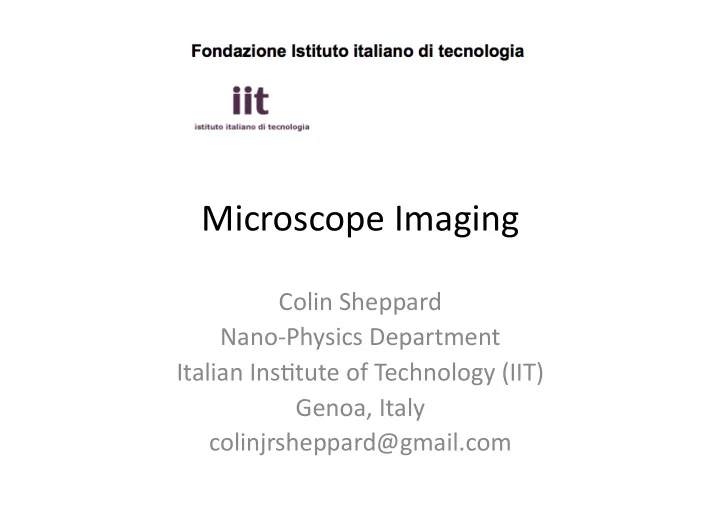

Microscope)Imaging) Colin)Sheppard) Nano5Physics)Department) Italian)Ins:tute)of)Technology)(IIT)) Genoa,)Italy) colinjrsheppard@gmail.com)
Op:cal)microscope) • Objec:ve)lens) – Numerical)aperture)( n )sin) α ) " – Air)/)oil)immersion)/)water)immersion) – Corrected)for)cover)slip)(No.)1) 1 / 2) =)0.17mm))or)not) – Corrected)for)infinity)or)not) – e.g)100X)1.4NA)Oil)0.17/∞) • Eyepiece) • Illumina:on)system)) – Condenser) – Aperture)stop)(diaphragm))) – Field)stop)
Airy)disc) ( ) 2 ⎛ ⎞ 2 J v = ⎜ ⎟ I 1 ⎝ v ⎠ ( ) 2 J 1 v → 1 for v → 0 v J 1 is a Bessel function Born & Wolf v = (2 π / λ ) n sin α" v is a normalized dimensionless optical coordinate
Rayleigh)criterion:)) resolu:on)of)two)points) Not resolved Resolved Bradbury, An introduction to the optical microscope
Rayleigh)two5point) resolu:on) • 2 points are just resolved if the second point is placed on the first dark ring of the first. • Separation is r 0 = 0.61 λ / ( n sin α ) Or separation is 2 v 0 = 3.84 v = (2 π / λ ) n sin α" v is a normalized dimensionless optical coordinate • Then the ratio of the intensity midway to that at the points is 0.735
Two5point)resolu:on) Dip changes quickly with separation
Resolu:on)depends)on)coherence) Vary condenser aperture (diaphragm) S = 0, coherent illumination S = 1, full, matched or complete illumination S → ∞ , incoherent illumination Fluorescence behaves as incoherent imaging Born and Wolf Resolution depends on coherence Coherence ratio S =
Images)of)two)points) small condenser equal apertures large condenser v 0 = 2.0 is close to the Rayleigh resolution for the incoherent case
Two5point)resolu:on) (S) L = v 0 / 2 π S = 0, L = 0.83 S = 1, L = 0.61 L = v 0 / π" S = 1.46, L = 0.56 best resolution (S~1.42) S Born & Wolf
Generalized)Rayleigh)two5point)resolu:on ) Points resolved when I (0) / I ( v = v 0 ) = 0.735 Intensity midway Intensity at the points, NOT intensity of the maxima separation
Generalized)Rayleigh)criterion ) • Defined)for)intensity) at#the#points# • Actually,)intensity)of)the) maxima )may)be)preferable)because)if ) we)do)not)know)the)magnifica:on)exactly)we)do)not)know) where)the)points)are!)(Modified)Rayleigh)criterion)) • FWHM)is)called)Houston)criterion) • Sparrow)criterion:)no)minimum)at)centre) • Kino’s)interpreta:on)of)Sparrow)criterion,)ra:o)=)1.)
Perfect)imaging) Object i φ ( x , y ) t ( x , y ) = a ( x , y ) e is modulus (amplitude), real is phase, real Perfect image • No phase information in perfect image
Image)forma:on)(coherent)case)) Add amplitudes of different parts of object. e.g. 2 points:
Coherent)imaging)
object 1st harmonic constant 3rd harmonic Fourier)series) for)periodic) func:on) sum of first three terms 2 π /k � = 1/m
Fourier)transforming)property)of)a)lens) F { U ( x )} U ( x ) f f Slope, position Position, slope
Abbe)theory)(coherent)imaging))
Abbe)theory) Introduce object spectrum
Coherent)transfer)func:on) CTF is Fourier transform of h Introduce object spectrum: 2 ∫∫ I ( x , y ) = c ( m , n ) T ( m , n )exp[2 π i ( mx + ny )]] dmdn spatial frequencies are filtered ∫ ∫ ∫ ∫ = c ∗ ( p , q ) T ( m , n ) T ∗ ( p , q )exp{2 π i [( m − p ) x + ( n − q ) y ]} dmdndpdq c ( m , n ) For partially coherent system C ( m , n ; p , q ) does not separate (complicated!)
Incoherent)imaging)
OTF)for)circular)aperture) • We)can)show)that)the)OTF)is)the)area)of)overlap)of)two)circles)(convolu:on),) which)is)) • This)looks)like)(Chinese)hat):) m • The)cut5off)frequency)is)twice)that)for)a)coherent)system) • For)an)object)which)is)only)a)func:on)of) x ,)i.e.) n )=)0) 1 0.8 C (m) 0.6 0.4 0.2 0.5 1 1.5 2 m -0.2
25D)transfer)func:ons)
Effect)of)defocus) • )If)system)is)defocused,)integrate)over)the) area)of)overlap,)taking)into)account)the)phase) of)the)pupil)(cannot)be)done)analy:cally).) • )Response)drops)off)with)defocus,)i.e.) imaging)of)higher)spa:al)frequency) components)is)worse.))It)is)the)mid5spa:al) frequencies)which)are)most)strongly)affected,) resul:ng)in)poorer)imaging.) • )OTF)can)go)nega:ve)with)defocus.))) • )OTF)must)always)be)purely)real)for)a)radially) symmetric)pupil)(not)for)coma!))) • )Some)spa:al)frequency)components)have) their)contrast)reversed.))This)results)in)op:cal) ar:facts,)which)means)that)you)can)see) something)that)is)not)really)there.) HH Hopkins, Proc.R. Soc. Lond.A 231 98 (1955) Born & Wolf
Siemens)star,) S )=)1 ) S. Mehta and R. Oldenbourg, "Image simulation for biological microscopy: microlith," Biomedical Optics Express 5 , 1822-1838 (2014).
Image)of)a)straight)edge) 1/3 S = 1 (full illumination) S = 0.32 (nearly coherent) B. M. Watrasiewicz, "Theoretical calculations of images of straight edges in partially coherent illumination," Optica Acta 12 , 391-400 (1965).
Straight)edge) • Image depends on coherence Slope is greater for small S , so greater precision for measurement - S = 0, slope =1/ π = 0.318 - S = 1, slope = 0.270 - S → ∞ , slope = 0.270 • Intensity at edge is - S = 0, 1/4 - S = 1, 1/3 - S → ∞ , 1/2 • Important for measuring (edge appears to be at 1/2) •Fringes for small S
Recommend
More recommend